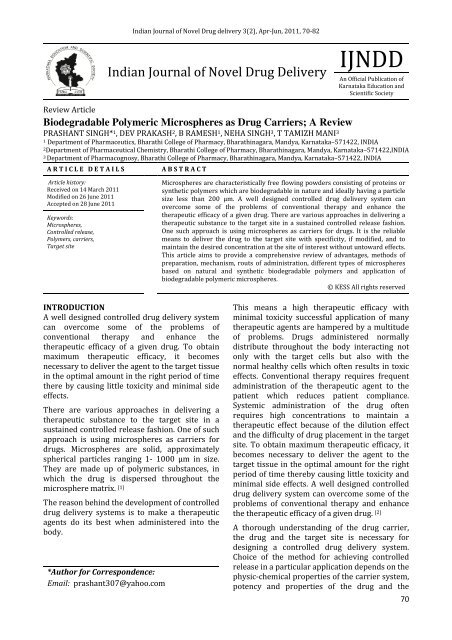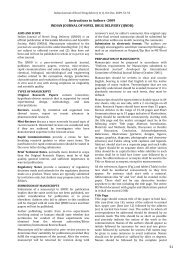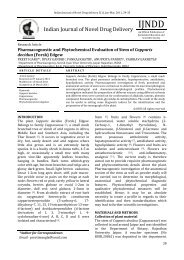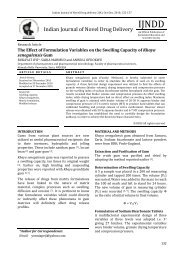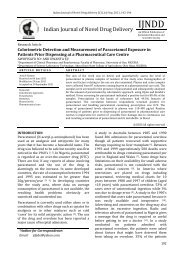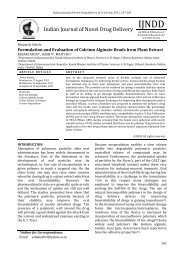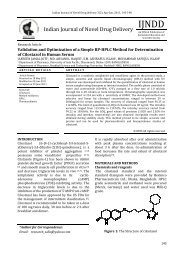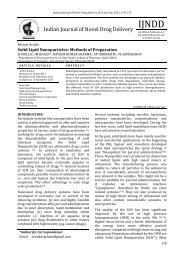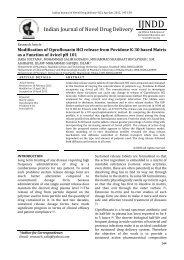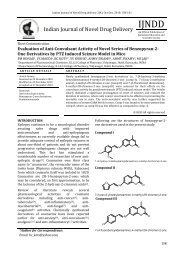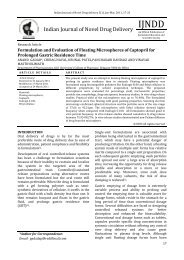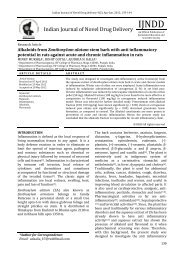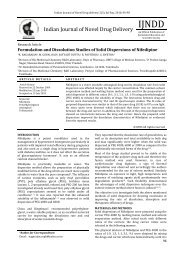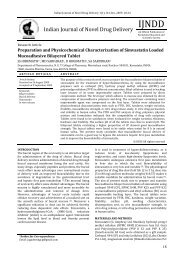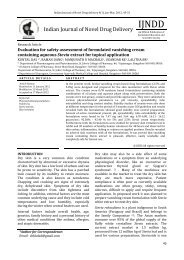Biodegradable Polymeric Microspheres as Drug Carriers; A Review
Biodegradable Polymeric Microspheres as Drug Carriers; A Review
Biodegradable Polymeric Microspheres as Drug Carriers; A Review
You also want an ePaper? Increase the reach of your titles
YUMPU automatically turns print PDFs into web optimized ePapers that Google loves.
Indian Journal of Novel <strong>Drug</strong> delivery 3(2), Apr-Jun, 2011, 70-82<br />
Indian Journal of Novel <strong>Drug</strong> Delivery<br />
IJNDD<br />
An Official Publication of<br />
Karnataka Education and<br />
Scientific Society<br />
<strong>Review</strong> Article<br />
<strong>Biodegradable</strong> <strong>Polymeric</strong> <strong>Microspheres</strong> <strong>as</strong> <strong>Drug</strong> <strong>Carriers</strong>; A <strong>Review</strong><br />
PRASHANT SINGH* 1 , DEV PRAKASH 2 , B RAMESH 1 , NEHA SINGH 3 , T TAMIZH MANI 3<br />
1 Department of Pharmaceutics, Bharathi College of Pharmacy, Bharathinagara, Mandya, Karnataka–571422, INDIA<br />
2Department of Pharmaceutical Chemistry, Bharathi College of Pharmacy, Bharathinagara, Mandya, Karnataka–571422,INDIA<br />
3 Department of Pharmacognosy, Bharathi College of Pharmacy, Bharathinagara, Mandya, Karnataka–571422, INDIA<br />
A R T I C L E D E T A I L S<br />
Article history:<br />
Received on 14 March 2011<br />
Modified on 26 June 2011<br />
Accepted on 28 June 2011<br />
Keywords:<br />
<strong>Microspheres</strong>,<br />
Controlled rele<strong>as</strong>e,<br />
Polymers, carriers,<br />
Target site<br />
A B S T R A C T<br />
<strong>Microspheres</strong> are characteristically free flowing powders consisting of proteins or<br />
synthetic polymers which are biodegradable in nature and ideally having a particle<br />
size less than 200 μm. A well designed controlled drug delivery system can<br />
overcome some of the problems of conventional therapy and enhance the<br />
therapeutic efficacy of a given drug. There are various approaches in delivering a<br />
therapeutic substance to the target site in a sustained controlled rele<strong>as</strong>e f<strong>as</strong>hion.<br />
One such approach is using microspheres <strong>as</strong> carriers for drugs. It is the reliable<br />
means to deliver the drug to the target site with specificity, if modified, and to<br />
maintain the desired concentration at the site of interest without untoward effects.<br />
This article aims to provide a comprehensive review of advantages, methods of<br />
preparation, mechanism, routs of administration, different types of microspheres<br />
b<strong>as</strong>ed on natural and synthetic biodegradable polymers and application of<br />
biodegradable polymeric microspheres.<br />
© KESS All rights reserved<br />
INTRODUCTION<br />
A well designed controlled drug delivery system<br />
can overcome some of the problems of<br />
conventional therapy and enhance the<br />
therapeutic efficacy of a given drug. To obtain<br />
maximum therapeutic efficacy, it becomes<br />
necessary to deliver the agent to the target tissue<br />
in the optimal amount in the right period of time<br />
there by causing little toxicity and minimal side<br />
effects.<br />
There are various approaches in delivering a<br />
therapeutic substance to the target site in a<br />
sustained controlled rele<strong>as</strong>e f<strong>as</strong>hion. One of such<br />
approach is using microspheres <strong>as</strong> carriers for<br />
drugs. <strong>Microspheres</strong> are solid, approximately<br />
spherical particles ranging 1- 1000 µm in size.<br />
They are made up of polymeric substances, in<br />
which the drug is dispersed throughout the<br />
microsphere matrix. [1]<br />
The re<strong>as</strong>on behind the development of controlled<br />
drug delivery systems is to make a therapeutic<br />
agents do its best when administered into the<br />
body.<br />
*Author for Correspondence:<br />
Email: pr<strong>as</strong>hant307@yahoo.com<br />
This means a high therapeutic efficacy with<br />
minimal toxicity successful application of many<br />
therapeutic agents are hampered by a multitude<br />
of problems. <strong>Drug</strong>s administered normally<br />
distribute throughout the body interacting not<br />
only with the target cells but also with the<br />
normal healthy cells which often results in toxic<br />
effects. Conventional therapy requires frequent<br />
administration of the therapeutic agent to the<br />
patient which reduces patient compliance.<br />
Systemic administration of the drug often<br />
requires high concentrations to maintain a<br />
therapeutic effect because of the dilution effect<br />
and the difficulty of drug placement in the target<br />
site. To obtain maximum therapeutic efficacy, it<br />
becomes necessary to deliver the agent to the<br />
target tissue in the optimal amount for the right<br />
period of time thereby causing little toxicity and<br />
minimal side effects. A well designed controlled<br />
drug delivery system can overcome some of the<br />
problems of conventional therapy and enhance<br />
the therapeutic efficacy of a given drug. [2]<br />
A thorough understanding of the drug carrier,<br />
the drug and the target site is necessary for<br />
designing a controlled drug delivery system.<br />
Choice of the method for achieving controlled<br />
rele<strong>as</strong>e in a particular application depends on the<br />
physic-chemical properties of the carrier system,<br />
potency and properties of the drug and the<br />
70
Pr<strong>as</strong>hant Singh et al / Indian Journal of Novel <strong>Drug</strong> Delivery 3(2), Apr-Jun, 2011, 70-82<br />
location and access to the target site. <strong>Drug</strong><br />
rele<strong>as</strong>e from a carrier matrix is governed by the<br />
interaction of the drug with the carrier matrix.<br />
For example, the free aldehyde in glutaraldehyde<br />
cross-linked microspheres react with certain<br />
drugs. Methitrexate reacts with glutarladehyde<br />
while adriamycin does not even though both<br />
contain an amino group. Accessibility of<br />
functional group may also exert an influence.<br />
Since the physico-chemical properties of each<br />
drug is often different, the rele<strong>as</strong>e profiles of<br />
different drugs can be different from a given<br />
matrix. It therefore become necessary to<br />
evaluate on detail the behavior of each in terms<br />
of its interaction with the matrix and the rele<strong>as</strong>e<br />
profile. [3]<br />
There are various approaches in delivering a<br />
therapeutic substance to the target site in a<br />
sustained or controlled rele<strong>as</strong>e f<strong>as</strong>hion. One such<br />
approach of using polymeric microspheres <strong>as</strong><br />
carriers for drugs. <strong>Microspheres</strong> for<br />
biodegradable and non-biodegradable polymers<br />
have been investigated for sustained rele<strong>as</strong>e<br />
depending on the final application. In the c<strong>as</strong>e of<br />
non-biodegradable drug carriers, when<br />
administered parentally, the carrier remaining in<br />
the body after the drug is completely rele<strong>as</strong>ed<br />
poses the possibility of carrier toxicity over a<br />
long period of time. <strong>Biodegradable</strong> carriers<br />
which degradable the body to non-toxic<br />
degradation products do not pose the problem of<br />
carrier toxicity and are more suited for<br />
parenteral application. Thus, emph<strong>as</strong>is in this<br />
review is on the approach of using biodegradable<br />
polymeric microspheres for achieving sustained<br />
rele<strong>as</strong>e. [4]<br />
MICROSPHERES AS DRUG CARRIERS<br />
Microsphere b<strong>as</strong>ed drug delivery have received<br />
considerable attention in recent years. The most<br />
important characteristic of microspheres of the<br />
microph<strong>as</strong>e separation morphology which<br />
endows it with a controllable variability in<br />
degradation rate and also drug rele<strong>as</strong>e.<br />
<strong>Microspheres</strong> b<strong>as</strong>ed on biodegradable<br />
polymers<br />
<strong>Biodegradable</strong> microspheres can be prepared<br />
from certain synthetic <strong>as</strong> well <strong>as</strong> natural<br />
polymers. An important requirement of such<br />
polymers is that the degradation products should<br />
be non-toxic because such products eventually<br />
enter circulation or result in tissue deposition.<br />
Long term toxicological evolution of the<br />
degradation products therefore is important in<br />
determining the clinical suitability of such<br />
carriers. Biodegradability carrier matrices can be<br />
designed to deliver the therapeutic agent for<br />
periods ranging from a few days to a few years.<br />
[5]<br />
Natural polymer such <strong>as</strong> proteins and<br />
polysaccharides undergo enzymatic degradation<br />
in the body. Most synthetic biodegradable<br />
polymers contain hydrolysable linkages like<br />
amide, esters, ure<strong>as</strong> and urethanes. Polypeptides<br />
undergo enzymatic degradation while synthetic<br />
polyesters such <strong>as</strong> poly(lactic acid) and<br />
poly(glycolic acid) degrade by simple hydrolysis.<br />
Enzymes area also reported to exert influence on<br />
the degradation of synthetic polyesters. [6]<br />
Homogeneous degradation or bulk degradation<br />
involves the cleavage of the bonds at a uniform<br />
rate throughout the matrix. Degradation in this<br />
c<strong>as</strong>e is independent of the surface area in<br />
heterogeneous or surface degradation, the rate of<br />
degradation is constant with time. [7,8]<br />
Preparation of microspheres<br />
The preparation of microspheres should satisfy<br />
certain criteria. They are:<br />
(i) The ability to incorporate re<strong>as</strong>onably<br />
concentrations of the drug,<br />
(ii) Stability of the preparation after synthesis<br />
with a clinically acceptable shelf-life,<br />
(iii) Controllable particle size and dispensability<br />
in aqueous vehicles for injection,<br />
(iv) Rele<strong>as</strong>e of active agent with good control<br />
over a wide time scale,<br />
(v) Biocompatibility with a controllable<br />
biodegradability, and<br />
(vi) Susceptibility to chemical modification.<br />
The preparation of microspheres from natural<br />
polymers involves three steps.<br />
First the solution of the polymer is disperse n a<br />
continuous medium such <strong>as</strong> vegetable oil or an<br />
organic solvent using a suitable agent. Dispersion<br />
is accomplished stirring or by ultr<strong>as</strong>onication or<br />
by high speed homogenization depending on the<br />
particle size required. The second step involves<br />
the hardening of the polymer droplets either by<br />
heat denaturation (in the c<strong>as</strong>e of proteins) or by<br />
chemical cross-linking using suitable crosslinking<br />
agent. The third step involves separation<br />
of the solid microspheres formed, purification<br />
and drying. [9]<br />
Chemical cross-linking of protein microspheres<br />
can be achieved using cross-linking agents such<br />
71
Pr<strong>as</strong>hant Singh et al / Indian Journal of Novel <strong>Drug</strong> Delivery 3(2), Apr-Jun, 2011, 70-82<br />
<strong>as</strong> formaldehyde, glutaraldehyde or by using<br />
diacid chlorides such a terephthalate chloride the<br />
method is also limited to drugs that do not have<br />
any chemical interaction with the cross-linking<br />
agent. for example glutaraldehyde interacts with<br />
salbutamol and methotrexate and formaldehyde<br />
interacts with eponephine.<br />
<strong>Microspheres</strong> of synthetic polymers could be<br />
prepared either by the polymerization of the<br />
monomer using the techniques of suspension or<br />
dispersion polymerization or from the polymer<br />
using a suitable solvent evaporation technique.<br />
[10]<br />
Various methods are employed for the<br />
preparation of the microspheres from polymers.<br />
Solvent evaporation is the most widely used<br />
technique. The polymer is dissolved in a suitable<br />
volatile solvent and dispersed in a continuous<br />
medium using a suitable stabilizing agent.<br />
Controlled evaporation of the solvent results in<br />
the formation of solid microspheres.<br />
Ph<strong>as</strong>e separation and spray drying are some<br />
other methods used for the preparation of<br />
microspheres. In ph<strong>as</strong>e separation, the drug<br />
particles are dispersed in a solution of the<br />
polymer and an incompatible polymer is added<br />
to the system which makes the first polymer to<br />
ph<strong>as</strong>e separate and engulf the drug particles.<br />
Addition of a non-solvent result in the<br />
solidification of the polymer. Poly (lactic acid)<br />
microspheres have prepared by this method by<br />
using polybutadiene <strong>as</strong> the incompatible<br />
polymer. Poly (lactic acid) microspheres have<br />
temperature of 37-50 o C, the solvent evaporation<br />
form in solid microspheres bearing porous net<br />
work and narrow size distribution. Polymers<br />
with low melting point can be fabricated into<br />
microspheres by the hot melt technique. The<br />
molten polymer is dispersed in suitable<br />
dispersion medium and slowly cooled to form<br />
the microspheres. The method h<strong>as</strong> been<br />
particularly successful in the c<strong>as</strong>e of<br />
polymerhyride which are susceptible to<br />
hydrolysis in the presence of moisture. [11]<br />
Method of drug incorporation<br />
<strong>Drug</strong>s are incorporated into the microspheres<br />
either during their synthesis or after the<br />
microspheres are formed. High loading can be<br />
achieved by in situ loading if the drug is insoluble<br />
in the dispersion medium employed for<br />
microsphere stabilization. W<strong>as</strong>hing the<br />
microspheres after their preparation to remove<br />
surfactants, oils, other impurities etc., using<br />
solvents in which the drug solubility is high may<br />
result in poor loading efficiency. In situ loading<br />
can not be employed for drugs which are affected<br />
by temperature of microsphere preparation,<br />
solvents employed, cross-linked agents etc. if the<br />
drug is heat sensitive, the resulting drug-loaded<br />
microspheres can not be sterilized by heat.<br />
Loading into preformed microspheres<br />
incorporated. The microsphere is swollen in a<br />
suitable solvent containing high concentration of<br />
the drug. The drug molecules diffuse into the<br />
matrix which is then dried to obtain drug-loaded<br />
microspheres. The method is best suited for<br />
cross-linked microspheres which do not dissolve<br />
but only swell when equilibrated in a suitable<br />
solvent. A high payload of water soluble drugs<br />
can be obtained if the microspheres are<br />
hydrophilic and swells to a high degree in<br />
aqueous solution. The method allows the most<br />
native form of the drug to be incorporated into<br />
the matrix. [12]<br />
<strong>Drug</strong>-polymer binding<br />
The binding force that holds the drug to the<br />
microsphere matrix can be physical or chemical.<br />
In addition to this, hydrophobic and electrostatic<br />
interaction may also exist. Depending on the<br />
force of attachment, drug rele<strong>as</strong>e from the matrix<br />
also varies. The drug rele<strong>as</strong>e is expected to be<br />
f<strong>as</strong>ter if only physical entrapment is achieved.<br />
<strong>Drug</strong> rele<strong>as</strong>e in such c<strong>as</strong>es is modulated by a<br />
diffusion controlled mechanism.<br />
Slow rele<strong>as</strong>e can be achieved by chemically<br />
binding the drug to the microsphere matrix. The<br />
polymer matrix should have reactive<br />
functionalities to which the drug can be bound<br />
through a functionality available on the drug. [13]<br />
<strong>Drug</strong>s can be either attached onto the preformed<br />
microsphere or a polymer-drug conjugate<br />
prepared by attaching the drug to the polymer<br />
chain can be further into the microsphere form.<br />
The linkage should be susceptible to degradation<br />
in the physiological environment so that the drug<br />
is rele<strong>as</strong>ed from the microsphere matrix. High<br />
loading is possible if sufficient functionalities to<br />
which drug can be bound exist on the polymer<br />
matrix. The drug rele<strong>as</strong>e in this c<strong>as</strong>e will depend<br />
on the rate of cleavage of the bond linking the<br />
drug to the matrix. [14]<br />
Route of administration<br />
<strong>Microspheres</strong> can be used for the delivery of<br />
drugs via different routes. Route of<br />
administration is selected depending on the drug<br />
properties, dise<strong>as</strong>e state being treated and the<br />
72
Pr<strong>as</strong>hant Singh et al / Indian Journal of Novel <strong>Drug</strong> Delivery 3(2), Apr-Jun, 2011, 70-82<br />
age and condition of the patient. Desirable<br />
properties of the microspheres to be used for the<br />
delivery will also change depending on the route<br />
of administration.<br />
(a) Oral delivery<br />
Oral delivery is the simplest way of drug<br />
administration. In oral drug delivery, the<br />
microspheres have to p<strong>as</strong>s through frequently<br />
changing environment in the GI tract. There is<br />
also patient to patient variation in GI content,<br />
stomach emptying time and peristaltic activity.<br />
Although constants of the oral route are<br />
numerous, on the whole, it offers less potential<br />
danger than the parenteral route. The relatively<br />
brief transit time of about 12 h through the GI<br />
tract limits the duration of action that can be<br />
expected via the oral route.<br />
Bioavailability of drugs with limited solubility in<br />
the stomach or intestine and small absorption<br />
rate constant can be incre<strong>as</strong>ed by incre<strong>as</strong>ing the<br />
retention time in the stomach. [15]<br />
(b) Parenteral Delivery<br />
Most of the microsphere b<strong>as</strong>e controlled delivery<br />
systems are developed with the aim of using<br />
them for parenteral administration. <strong>Drug</strong> is<br />
completely absorbed in this c<strong>as</strong>e. <strong>Microspheres</strong><br />
used for parenteral delivery should be sterile and<br />
should be dispersible in a suitable vehicle for<br />
injection. Hydrophilic microspheres have the<br />
potential advantage of aqueous dispersibility <strong>as</strong><br />
opposed to hydrophobic microspheres for<br />
reconstituting them for injection. Surfactants in<br />
small concentrations are often necessary for<br />
reconstituting hydrophobic particles for injection<br />
in aqueous vehicle which are reported to cause<br />
adverse tissue reaction and affect the rele<strong>as</strong>e of<br />
the incorporated drug. [16]<br />
Fate of microspheres in the body<br />
Knowledge of the fate of microspheres after<br />
parenteral administration is very important in<br />
designing a drug delivery system. The biological<br />
fate of the administered particles h<strong>as</strong> been<br />
studied by radiolabelled techniques. 14 C, 131 I, 125 I<br />
and 9 Tc have been used for labeling.<br />
Another method for the estimation of<br />
microspheres administered into the body is by<br />
using magnetite. Magnetite eatimation h<strong>as</strong> the<br />
advantage that it can be e<strong>as</strong>ily incorporated into<br />
the microsphere matrix by physical entrapment<br />
without altering the chemical nature of the<br />
matrix. The recovery of the microspheres from<br />
the target organs can be achieved with the aid of<br />
an atomic absorption spectrophotometer.<br />
MECHANISM OF DRUG RELEASE<br />
Theoretically, the rele<strong>as</strong>e of drugs from<br />
biodegradable microspheres can be cl<strong>as</strong>sified<br />
broadly into four different categories. But in<br />
actual practice, the mechanism is more complex<br />
and an interplay of different mechanisms may<br />
operate. [17]<br />
Degradation controlled monolithic system<br />
In degradation controlled monolithic<br />
microsphere systems, the drug is dissolved in the<br />
matrix and is distributed uniformly throughout.<br />
The drug is strongly to the matrix and is rele<strong>as</strong>ed<br />
only on degradation of the matrix. The diffusion<br />
of the drug is slow compared with the<br />
degradation of the matrix. When degradation is<br />
by homogeneous bulk mechanism, drug rele<strong>as</strong>e<br />
is slow initially and incre<strong>as</strong>es rapidly when rapid<br />
bulk degradation starts. <strong>Drug</strong> rele<strong>as</strong>e from such<br />
type of devices is independent of the geometry of<br />
the device.<br />
Rele<strong>as</strong>e from a sphere is governed by the<br />
equation, where M t is the amount of the agent<br />
rele<strong>as</strong>ed at time t, M ∞ is the amount at time t ∞ is<br />
the time for total erosion. Progesterone rele<strong>as</strong>e<br />
from poly (glycolic-co-lactic acid) polymer films<br />
containing 10 weight% steroids is an example of<br />
this type of rele<strong>as</strong>e.<br />
M t /M ∞ = 1-[(1-t/ t ∞)] 3<br />
Diffusion controlled monolithic system<br />
Here the active agent is rele<strong>as</strong>ed by diffusion<br />
prior to or concurrent with the degradation of<br />
the polymer matrix. Degeneration of the polymer<br />
matrix affects the rate of rele<strong>as</strong>e and h<strong>as</strong> to be<br />
taken into account. Rate of rele<strong>as</strong>e also depends<br />
on whether the polymer degrades by<br />
homogeneous or heterogeneous mechanism.<br />
Diffusion controlled reservoir systems<br />
Here the active agent is encapsulated by a rare<br />
controlling membrane through which the agent<br />
diffuses and the membrane erodes only after its<br />
delivery is completed. In this c<strong>as</strong>e, drug rele<strong>as</strong>e is<br />
unaffected by the degradation of the matrix.<br />
Polymer that remains <strong>as</strong> such till the complete,<br />
rele<strong>as</strong>e of drug and then degrades by<br />
homogenous mechanism so that the device is<br />
removed from the body is better for this type of<br />
delivery.<br />
73
Pr<strong>as</strong>hant Singh et al / Indian Journal of Novel <strong>Drug</strong> Delivery 3(2), Apr-Jun, 2011, 70-82<br />
Erodible poly-agent system<br />
In this c<strong>as</strong>e the active agent is chemically<br />
attached to the matrix and the rate of<br />
biodegradation of the matrix is slow compared to<br />
the rate of hydrolysis of drug polymer bond.<br />
Assuming that the rate of diffusion of the active<br />
agent from the matrix to the surrounding is<br />
rapid, the limiting step is the rate of cleavage of<br />
the bond attaching drug to the polymer matrix.<br />
[18]<br />
TARGETING OF MICROSPHERES<br />
Targeting is achieved by exploiting the natural<br />
pattern of a drug carrier called p<strong>as</strong>sive targeting<br />
i.e. by changing the natural pattern of the carrier<br />
by some means thereby directing the drug to the<br />
specific organ or tissue. This is called active<br />
targeting.<br />
P<strong>as</strong>sive Targeting<br />
Particles administered into the body<br />
intravenously will distribute itself in different<br />
organs depending on the size of the particles.<br />
The administered particles p<strong>as</strong>s through the<br />
heart with little or no uptake to the lungs where<br />
particles > 7 µm get entrapped in the capillary<br />
beds. Particles < 7µm enter into the systemic<br />
circulation. [19]<br />
Active targeting<br />
Active targeting includes coating the<br />
microspheres with hydrophilic cating agents<br />
which suppresses opsonization . With colloidal<br />
particles are administered into the blood<br />
streams, they may be coated with proteins such<br />
<strong>as</strong> albumin, globulin etc., depending on the<br />
nature of the material, surface charge and<br />
hydrophilicity of the particles. This is called<br />
opsonization. By coating the particles with<br />
certain polymers like poloxamer, opzonization<br />
and removal of particles by macrophages can be<br />
reduced. It is thus possible to direct particles<br />
within the body to sites such <strong>as</strong> the lung, the<br />
liver, the bone marrow or to retain them for<br />
longer periods within the systemic circulation.<br />
[20]<br />
Targeting using magnetic microspheres<br />
Another approach in this area is by using<br />
magnetic microspheres. In this method magnetic<br />
loaded microspheres is infused into an artery<br />
supplying a given target site. A magnet is placed<br />
externally over the target area which restricts<br />
the microsphere to that area. [21]<br />
Intracellular targeting<br />
Certain cytotoxic drugs are active intracellularly,<br />
but are normally discarded due to their poor<br />
intracellular influx. Intracellular pathogens are<br />
usually protected from the immune system and<br />
the chemotherapeutic agents. The poor efficacy<br />
of many therapeutic substances for intracellular<br />
bacterial and par<strong>as</strong>itic therapy is well knowm.<br />
Commonly phagocytic cells are the sites of<br />
intracellular infection. Intracellular delivery of<br />
drugs by suitable means can obviate these<br />
problems. [22]<br />
Albumin microspheres were avidly taken up by<br />
macrophages. They have also observed that<br />
biologically active streptomycin w<strong>as</strong> rele<strong>as</strong>ed<br />
from albumin microspheres inside the<br />
phagocytic cells after ingestion and intracellular<br />
degradation of microspheres.<br />
MICROSPHERES BASED ON NATURAL<br />
POLYMERS<br />
Protein and polysaccharides have been<br />
extensively investigated for targeted drug<br />
delivery. Natural polymers have the advantage<br />
that they pose less toxicity problems of their<br />
own. Majority of the natural polymers are<br />
susceptible to biodegradation and are generally<br />
biocompatible. A major problem with<br />
biopolymers is the presence of antigenic<br />
determinants in them. Biopolymers also differ in<br />
their molecular weight and their physical and<br />
chemical properties to varying extents<br />
depending on the source and method of isolation<br />
and purification.<br />
Albumin microspheres<br />
Proteins have attained considerable attention <strong>as</strong><br />
drug carriers because of the selective uptake in<br />
tumor cells coupled with known liposomal active<br />
of many cells which is necessary for the<br />
breakdown of the polymer-drug complex.<br />
Moreover, the large m=number of functional<br />
groups present in proteins offer sites for<br />
attachment of the drug. Proteins can be<br />
combined with selection of drugs to generate<br />
derivatives whose properties are often<br />
significantly different from the free drug.<br />
Albumin microspheres received considerable<br />
attention because of their specific organ<br />
targeting property, biocompatibility and nonantigenicity<br />
in the cross-linked or heat<br />
denatured form. The preparation procedure<br />
involves dispersion of the aqueous albumin<br />
solution in a suitable medium, solidification of<br />
74
Pr<strong>as</strong>hant Singh et al / Indian Journal of Novel <strong>Drug</strong> Delivery 3(2), Apr-Jun, 2011, 70-82<br />
the dispersed ph<strong>as</strong>e and separation of the microparticles<br />
formed.<br />
<strong>Drug</strong> rele<strong>as</strong>e from albumin microspheres can be<br />
controlled by changing their cross-linking<br />
density and the drug albumin ratio. But high<br />
cross-linking retards the rate of degradation.<br />
<strong>Drug</strong> to albumin ratio h<strong>as</strong> its limiting factors<br />
such <strong>as</strong> solubility of the drug in albumin solution<br />
and the burst effect that occurs at high drug<br />
payloads. This can be chemically attaching the<br />
drug to the protein. Since there are many<br />
functionalities in the protein to which the drug<br />
can be anchored, high payloads can he obtained<br />
by chemically binding the drug to the matrix.<br />
Albumin binds many drugs strongly and this<br />
binding would drug retard drug rele<strong>as</strong>e from an<br />
injection site until the microspheres are<br />
degraded by proteolytic enzymes. Albumin<br />
microspheres of suitable size have been found to<br />
be useful for localized drug delivery. Albumin<br />
microspheres have also been investigated for<br />
oral drug delivery. Retention of the microsperes<br />
in the stomach can be improved by mixing<br />
microspheres with a bioadhesive polymer. [23]<br />
C<strong>as</strong>ein microspheres<br />
Serum albumin microspheres are prepared from<br />
albumin separated from outdated human blood.<br />
With the prevalence of AIDS, the risk of viral<br />
contamination in blood used for the preparation<br />
of albumin is a possibility. Recently there h<strong>as</strong><br />
been considerable interest in the milk protein<br />
c<strong>as</strong>ein <strong>as</strong> a carrier for drugs.<br />
The biodegradation rate of albumin and c<strong>as</strong>ein<br />
microspheres by radiolabelled techniques and<br />
found that c<strong>as</strong>ein system degraded slowly<br />
compared to albumin. [24]<br />
Gelatin microspheres<br />
It is nontoxic, biocompatible and biodegradable.<br />
First order rele<strong>as</strong>e w<strong>as</strong> obtained for gelatin<br />
microspheres while zero order rele<strong>as</strong>e w<strong>as</strong><br />
obtained from ethyl cellulose coated<br />
microspheres. Gelatin nanoparticles are reported<br />
to be taken up by some tumour cells which do<br />
not take albumin nanoparticles. [25]<br />
Polysaccharide microspheres<br />
Biocompatibility and biodegradability of many<br />
naturally occurring polysaccharides make them<br />
useful <strong>as</strong> drug carriers. Chitin, starch, dextran<br />
etc., are some polysaccharides used in drug<br />
delivery applications. Many investigations have<br />
been reported on the use of chitin, chitosan and<br />
their derivatives <strong>as</strong> drug carriers for targeted,<br />
controlled or sustained delivery of drugs . It h<strong>as</strong><br />
been demonstrated that partially deacetylated<br />
chitin is a substrate for lysozyne.<br />
Partially deacetylated chitin and its<br />
glutaraldehyde cross-linked hydrogels are<br />
degraded by lysozyme but the degradation rate<br />
is reported to be rather slow. There are many<br />
reports on the use of chitosan <strong>as</strong> a drug carrier<br />
for oral and parenteral formulations. The rele<strong>as</strong>e<br />
of drugs from the microsphere matrix w<strong>as</strong> a<br />
function of the cross-linking density of the<br />
microspheres, drug payload, particle size and<br />
aqueous solubility of the drug. Chitosan<br />
microspheres prepared by the glutaraldehyde<br />
cross-linking of an aqueous acetic acid<br />
dispersion of chitosan have loaded with proteins<br />
such <strong>as</strong> bovine serum albumin (BSA) and the<br />
rele<strong>as</strong>e w<strong>as</strong> examined in vitro.<br />
Implantation of the placebo chitosan<br />
microspheres in the gluteal muscle of rats h<strong>as</strong><br />
shown that the glutaraldehyde cross-linked<br />
microspheres were well tolerated by the tissue<br />
and were not degraded completely even after six<br />
months. The degradation appeared to be mostly<br />
due to surface erosion. These studies have<br />
demonstrated the potential of cross-linked<br />
chitosan microspheres <strong>as</strong> a potential drug carrier<br />
for the prolonged delivery of drugs and<br />
macromolecules such <strong>as</strong> polypeptides.<br />
Starch microspheres have also have been<br />
investigated for drug delivery. Starch is one of<br />
the most abundant biopolymers consisting of<br />
glucopyranose units and hydrolyzes completely<br />
to yield D-glucose. Because of the presence of<br />
free OH groups in starch, it is susceptible to<br />
derivatization with a number of reagents. Due to<br />
their biocompatibility and biodegradability,<br />
starch microspheres of size 15-80 µm diameter<br />
were used for the temporary embolization to<br />
improve regional drug delivery.<br />
Dextran also attracted attention <strong>as</strong> a drug carrier<br />
because of it biocompatibility and<br />
biodegradability. The polymer is also susceptible<br />
to chemical transformations using a variety of<br />
regents. Carboxylated or sulphonated polymer<br />
can be prepared by carboxymethylation or<br />
sulphopropylation. This acts <strong>as</strong> cation exchange<br />
drug carrier. Anionic group of carboxylated or<br />
sulphonated dextran interacts with b<strong>as</strong>ic group<br />
of drug such <strong>as</strong> adriamycin to form ionic salt<br />
complex. This salt exchange the free drug for<br />
other cations. [26]<br />
75
Pr<strong>as</strong>hant Singh et al / Indian Journal of Novel <strong>Drug</strong> Delivery 3(2), Apr-Jun, 2011, 70-82<br />
MICROSPHERES OF SYNTHETIC<br />
BIODEGRADABLE POLYMERS<br />
Synthetic polymers have the advantage that can<br />
be e<strong>as</strong>ily and reproducibly prepared. They can be<br />
copolymerized with one another to alter their<br />
physical, chemical and mechanical properties<br />
and can be prepared <strong>as</strong> low or high molecular<br />
weight materials by suitable reaction conditions.<br />
Chemical bonds which are susceptible to<br />
degradation include amides, esters, ortho esters,<br />
acetals, glycosides and related groups.<br />
Biodegradability of the polymer depends on<br />
many factors such <strong>as</strong> polymer structure,<br />
molecular weight, the physical form of the<br />
implanted material and the environment in<br />
which the polymer is placed. Since many<br />
proteolytic enzymes specifically catalyse the<br />
hydrolysis of peptide linkage adjacent to<br />
substituents in proteins, substituted polymers<br />
containing benzyl, hydroxyl, carboxymethyl and<br />
phenyl groups have been prepared to improve<br />
biodegradability.<br />
Polyester microspheres<br />
Aliphatic polyesters have been extensively<br />
investigated <strong>as</strong> drug carriers. Degradation<br />
mechanism for all polyesters appears to e due to<br />
homogeneous erosion by random hydrolytic<br />
chain scission. Poly (lactic acid), poly(glycolic<br />
acid) and their copolymers have been<br />
extensively studied <strong>as</strong> drug carriers. The most<br />
important property of these polymers which<br />
makes them attractive <strong>as</strong> degradable drug<br />
carriers is that they form endogenous<br />
metabolites lactic and glycolic acids on<br />
biodegradation. Effect of enzymes on the<br />
biodegradation of these polymers is a subject of<br />
controversy. They possess excellent tissue<br />
compatibility. The polymers have prepared in<br />
microspherical form for use <strong>as</strong> drug carriers by<br />
the solvent evaporation techniques. Methylene<br />
chloride is the solvent usually employed for<br />
dissolving the polymer. If the drug incorporated<br />
is insoluble in the solvent used for dissolving the<br />
polymer, drug is distributed <strong>as</strong> discrete particles<br />
through the microsphere. If the drug is<br />
completely soluble, it could crystallize <strong>as</strong> the<br />
solvent evaporates to give discrete drug-rich<br />
domains scattered throughout the microsphere<br />
matrix or should remain molecularly dispersed<br />
in the matrix and not crystallize. Low<br />
temperature ph<strong>as</strong>e separation h<strong>as</strong> been another<br />
method used for the preparation of polylactide<br />
microspheres. <strong>Drug</strong>s particles are dispersed in<br />
the polymer solution and a non-solvent is added<br />
to desolvate the polymer and the microspheres<br />
formed are separated. The lactide and glycolide<br />
polymer induce minimal inflammatory response<br />
when introduced into the body. The degradation<br />
products are removed by body constituents. The<br />
rate of degradation of copolymers depend on the<br />
ratio of poly(Lactic acid) to poly(glycolic acid) in<br />
the copolymer. The polymers in their<br />
microspherical form have been studied <strong>as</strong><br />
carriers for the prolonged delivery of a number<br />
of drugs and <strong>as</strong> an embolization agent. [27]<br />
Polyanhydride microspheres<br />
Polyanhydrides have received incre<strong>as</strong>ing<br />
attention in recent years because they are<br />
biocompatible and non toxic. the e<strong>as</strong>ily<br />
hydrolysable linkage makes it possible to<br />
prepare anhydrides with wide range of<br />
degradation rates by changing the chemical<br />
structure of the back bone. Highly hydrophobic<br />
polyanhydrides degrade by surface erosion.<br />
Degradation rate w<strong>as</strong> found to change with the<br />
length of the alkyl group in the polymer<br />
backbone degradation rate can also be varied by<br />
copolymerizing with sebacic acid. By changing<br />
the composition of the copolymer a wide range<br />
of degradation rate can be obtained. But the<br />
presence of hydrophilic matrix causes the rele<strong>as</strong>e<br />
of drug by diffusion and a good correlation<br />
between drug rele<strong>as</strong>e and polymer degradation<br />
is not obtained. Because the anhydride bond is<br />
highly sensitive to water, normal method of<br />
microsphere preparation like solvent<br />
evaporation cannot be used which requires an<br />
aqueous ph<strong>as</strong>e. <strong>Microspheres</strong> are made from<br />
polyanhydrides by interfacial condensation and<br />
by hot melt technique. <strong>Microspheres</strong> made by<br />
polycondensation method were found to e<br />
irregular in shape and had a rough surface.<br />
Rele<strong>as</strong>e w<strong>as</strong> found to be f<strong>as</strong>t and polymer<br />
degradation always lagged behind the drug<br />
rele<strong>as</strong>e. [28]<br />
Methods of Preparation<br />
Preparation of microspheres should satisfy<br />
certain criteria:<br />
a) The ability to incorporate re<strong>as</strong>onably high<br />
concentrations of the drug.<br />
b) Stability of the preparation after synthesis<br />
with a clinically acceptable shelf life.<br />
c) Controlled particle size and dispersibility in<br />
aqueous vehicles for injection.<br />
d) Rele<strong>as</strong>e of active reagent with a good control<br />
over a wide time scale.<br />
e) Biocompatibility with a controllable<br />
biodegradability and<br />
f) Susceptibility to chemical modification.<br />
76
Pr<strong>as</strong>hant Singh et al / Indian Journal of Novel <strong>Drug</strong> Delivery 3(2), Apr-Jun, 2011, 70-82<br />
Methods use of preparation of microspheres<br />
1. Solvent evaporation method,<br />
a) Single emulsion technique.<br />
b) Double emulsion technique.<br />
2. Coacervation ph<strong>as</strong>e separation method.<br />
3. Spray drying and spray congealing method.<br />
4. Polymerization method.<br />
General methods of preparation<br />
Choice of the technique mainly depends on the<br />
nature of the polymer used, the drug, he<br />
intended use & the duration of therapy. These<br />
include in situ polymerization, solvent<br />
evaporation, coacervation-ph<strong>as</strong>e separation,<br />
spray drying & spray congealing, etc.<br />
1. Solvent Evaporation Method<br />
a) Single emulsion technique:<br />
The microparticulate carriers of natural<br />
polymers, i.e. those of proteins & carbohydrates<br />
are prepared by single emulsion technique. The<br />
natural polymers are dissolved/ dispersed in<br />
aqueous medium followed by dispersion in the<br />
non aqueous medium. Ex: oil. In the 2 nd step,<br />
cross linking of the dispersed globule is carried<br />
out either by means of heat or by using chemical<br />
cross linkers. The chemical cross linking agents<br />
used –gluteraldehyde, formaldehyde,<br />
terephthalate chloride, diacidchloride, etc.<br />
Crosslinking by heat is effected by adding the<br />
dispersion to previously heated oil. Heat<br />
denaturation is not suitable for the thermolabile<br />
drugs while the chemical cross-linking suffers<br />
disadvantage of excessive exposure of active<br />
ingredient to chemicals if added at the time of<br />
preparation. [29] (Fig.1)<br />
b) Double emulsion technique<br />
Involves the formation of the multiple emulsions<br />
or the double emulsion of type w/o/w & is best<br />
suited to the water soluble drugs, peptides,<br />
proteins & the vaccines.<br />
The aqueous protein solution is dispersed in a<br />
lipophilic organic continuous ph<strong>as</strong>e which is<br />
generally consisted of polymer solution that<br />
eventually encapsulates protein contained in<br />
dispersed aqueous ph<strong>as</strong>e. The primary emulsion<br />
is then subjected to the homogenization before<br />
addition to aqueous solution of PVA .this results<br />
in formation of double emulsion which is then<br />
subjected to solvent removal by solvent<br />
evaporation maintaining the emulsion at reduced<br />
pressure or by stirring so that organic ph<strong>as</strong>e<br />
evaporates out. [30] (Fig.2)<br />
Examples: hydrophilic drugs like LHRH agonist,<br />
vaccines and proteins.<br />
2. Coacervation ph<strong>as</strong>e separation method<br />
Specially designed for preparing the reservoir<br />
type of the system, i.e., to encapsulate water<br />
soluble drugs e.g. peptides, proteins, matrix type<br />
particularly, when the drug is hydrophobic in<br />
nature e.g., steroids. In matrix type device, the<br />
drug or the protein is soluble in the polymer<br />
ph<strong>as</strong>e. The process is b<strong>as</strong>ed on the principle of<br />
decre<strong>as</strong>ing the solubility of the polymer in the<br />
organic ph<strong>as</strong>e to affect the formation of the<br />
polymer rich ph<strong>as</strong>e called the coacervates. The<br />
coacervation can be brought about by addition of<br />
the third component to the system which results<br />
in the formation of the two ph<strong>as</strong>es, one i.e.<br />
supernatant, depleted of the polymer.<br />
In this technique, the polymer is first dissolved in<br />
a suitable solvent & then drug is dispersed by<br />
making its aqueous solution, if hydrophilic or<br />
dissolved in t he polymer solution itself, if<br />
hydrophobic. Ph<strong>as</strong>e separation is then<br />
accomplished by changing the solution<br />
conditions. [31] (Fig.3)<br />
3. Spray drying and spray congealing:<br />
These methods are b<strong>as</strong>ed on the drying of the<br />
mist of the polymer and drug in the air.<br />
Depending upon the removal of the solvent or<br />
cooling of the solution, the two processes are<br />
named spray drying and spray congealing<br />
respectively. The polymer is first dissolved in a<br />
suitable volatile organic solvent such <strong>as</strong><br />
dichloromethane, acetone, etc. The drug in the<br />
solid form is then dispersed in the polymer<br />
solution under high speed homogenization. This<br />
dispersion is then atomized in a stream of hot air.<br />
The atomization leads to the formation of the<br />
small droplets or the fine mist from which the<br />
solvent evaporates instantaneously leading the<br />
formation of the microspheres in a size range 1-<br />
100 μm. Microparticles are separated from the<br />
hot air by means of the cyclone separator while<br />
the traces of solvent are removed by vacuum<br />
drying. One of the major advantages of the<br />
process is fe<strong>as</strong>ibility of operation under <strong>as</strong>eptic<br />
conditions. The spray drying process is used to<br />
encapsulate various penicillins. Thiamine<br />
mononitrate and sulpha ethylthiadizole are<br />
encapsulated in a mixture of mono- and<br />
diglycerides of stearic acid and palmitic acid<br />
using spray congealing. Very rapid solvent<br />
evaporation, however leads to the formation of<br />
porous microparticles. [32] (Fig.4)<br />
77
Pr<strong>as</strong>hant Singh et al / Indian Journal of Novel <strong>Drug</strong> Delivery 3(2), Apr-Jun, 2011, 70-82<br />
Figure 1: Processing scheme for microspheres-preparation by single emulsion technique<br />
Figure 2: Processing scheme for microspheres-preparation by double emulsion technique<br />
Figure 3: Coacervation ph<strong>as</strong>e separation method<br />
Figure 4: Spray drying and spray congealing<br />
78
Pr<strong>as</strong>hant Singh et al / Indian Journal of Novel <strong>Drug</strong> Delivery 3(2), Apr-Jun, 2011, 70-82<br />
Figure 5: Polymerization method<br />
4. Polymerization method<br />
I. Normal polymerization<br />
II. Interfacial polymerization.<br />
NORMAL POLYMERIZATION<br />
Proceeds using techniques like bulk, suspension<br />
precipitation, emulsion & micellar<br />
polymerization processes. In bulk<br />
polymerization, a monomer along with initiator<br />
is heated to initiate polymerization. Initiator is<br />
added to accelerate the rate of reaction. <strong>Drug</strong> is<br />
added during process of polymerization. The<br />
polymer so obtained is fragmented to<br />
microspheres.<br />
ADVANTAGE - Formation of the pure polymer,<br />
DISADVANTAGE - Very difficult to dissipate the<br />
heat of reaction, which can adversely effect the<br />
thermolabile active ingredients. [33]<br />
SUSPENSION POLYMERIZATION<br />
Suspension polymerization is also called <strong>as</strong><br />
bead/pearl polymerization. Carried out by<br />
heating the monomer or mixture of monomers<br />
with active principles(drug) <strong>as</strong> droplets<br />
dispersion in a continuous ph<strong>as</strong>e. The droplets<br />
may also contain an initiator & other additives.<br />
The emulsion polymerization, differs from the<br />
suspension polymerization <strong>as</strong> due to presence of<br />
initiator in the aqueous ph<strong>as</strong>e, which later on<br />
diffuses to the surface of the micelles or the<br />
emulsion globules.<br />
The suspension & emulsion polymerization can<br />
be carried out at lower temperature, since<br />
continuous external ph<strong>as</strong>e is normally water<br />
through which heat can e<strong>as</strong>ily dissipate. The 2<br />
processes also lead to the formation of higher<br />
mol. wt polymer at relatively f<strong>as</strong>ter rate.<br />
Major disadvantage of suspension & emulsion<br />
polymerization - <strong>as</strong>sociation of polymer with the<br />
unreacted monomer & other additives. [34]<br />
INTERFACIAL POLYMERIZATION:<br />
Involves reaction of various monomers at the<br />
interface between the 2 immiscible liquid ph<strong>as</strong>es<br />
to form a film of polymer that essentially<br />
envelopes the dispersed ph<strong>as</strong>e. In this 2 reacting<br />
monomers are employed one of which is<br />
dissolved in the continuous ph<strong>as</strong>e while the<br />
other being dispersed in the continuous ph<strong>as</strong>e.<br />
Monomer present in either ph<strong>as</strong>es diffuse<br />
rapidly 7 polymerize rapidly at the interface. If<br />
the polymer is soluble in the droplet it will lead<br />
to the formation of monolithic type of the carrier<br />
on the other hand if polymer is insoluble in the<br />
monomer droplet, the formed carrier is of<br />
capsular(reservoir) type. The degree of<br />
polymerization can be controlled by the<br />
reactivity of monomer chosen, their<br />
concentration, the composition of the vehicle of<br />
either ph<strong>as</strong>es & by the temperature of the<br />
system. The particle size can be controlled by<br />
controlling the droplets or globule size of the<br />
disperse ph<strong>as</strong>e. The polymerization reaction can<br />
be controlled by maintaining the concentration<br />
of the monomers, which can be achieved by the<br />
addition of an excess of the continuous ph<strong>as</strong>e.<br />
[35](Fig.5)<br />
79
Pr<strong>as</strong>hant Singh et al / Indian Journal of Novel <strong>Drug</strong> Delivery 3(2), Apr-Jun, 2011, 70-82<br />
<strong>Drug</strong> loading and drug rele<strong>as</strong>e kinetics<br />
The active components are loaded over the<br />
microspheres principally using two methods, i.e.<br />
during the preparation of the microspheres or<br />
after the formation of the microspheres by<br />
incubating them with the drug/protein. The<br />
active component can be loaded by means of the<br />
physical entrapment, chemical linkage and<br />
surface adsorption. The entrapment largely<br />
depends on the method of preparation and<br />
nature of the drug or polymer (monomer if<br />
used). Maximum loading can be achieved by<br />
incorporating the drug during the time of<br />
preparation but it may get affected by many<br />
other process variables such <strong>as</strong> method of<br />
preparation, presence of additives (e.g. cross<br />
linking agent, surfactant stabilizers, etc.) heat of<br />
polymerization, agitation intensity, etc. Rele<strong>as</strong>e<br />
of the active constituent is an important<br />
consideration in c<strong>as</strong>e of microspheres. The<br />
rele<strong>as</strong>e profile from the microspheres depends<br />
on the nature of the polymer used in the<br />
preparation <strong>as</strong> well <strong>as</strong> on the nature of the active<br />
drug. The rele<strong>as</strong>e of drug from both<br />
biodegradable <strong>as</strong> well <strong>as</strong> non-biodegradable<br />
microspheres is influenced by structure or<br />
micro-morphology of the carrier and the<br />
properties of the polymer itself.<br />
The drugs could be rele<strong>as</strong>ed through the<br />
microspheres by any of the three methods, first<br />
is the osmotically driven burst mechanism,<br />
second by pore diffusion mechanism, and third<br />
by erosion or the degradation of the polymer. In<br />
osmotically driven burst mechanism, water<br />
diffuse into the core through biodegradable or<br />
non-biodegradable coating, creating sufficient<br />
pressure that ruptures the membrane. The burst<br />
effect is mainly controlled by three factors the<br />
macromolecule/polymer ratio, particle size of<br />
the dispersed macromolecule and the particle<br />
size of the microspheres. The pore diffusion<br />
method is named so because <strong>as</strong> penetrating<br />
water front continue to diffuse towards the core.<br />
The polymer erosion, i.e. loss of polymer is<br />
accompanied by accumulation of the monomer in<br />
the rele<strong>as</strong>e medium. The erosion of the polymer<br />
begins with the changes in the microstructure of<br />
the carrier <strong>as</strong> water penetrates within it leading<br />
to the pl<strong>as</strong>ticization of the matrix.<br />
<strong>Drug</strong> rele<strong>as</strong>e from the non-biodegradable type of<br />
polymers can be understood by considering the<br />
geometry of the carrier. The geometry of the<br />
carrier, i.e. whether it is reservoir type where the<br />
drug is present <strong>as</strong> core, or matrix type in which<br />
drug is dispersed throughout the carrier, governs<br />
overall rele<strong>as</strong>e profile of the drug or active<br />
ingredients. [36,37]<br />
Applications [38]<br />
• Assay - Coated microspheres provide<br />
me<strong>as</strong>uring tool in biology and drug research.<br />
• Buoyancy - Hollow microspheres are used to<br />
decre<strong>as</strong>e material density in pl<strong>as</strong>tics (gl<strong>as</strong>s and<br />
polymer).<br />
• Ceramics - Used to create porous ceramics<br />
used for filters (microspheres melt out during<br />
firing, Polyethylene <strong>Microspheres</strong>)<br />
• Cosmetics - Opaque microspheres used to hide<br />
wrinkles and give color, Clear microspheres<br />
provide "smooth ball bearing" texture during<br />
application (Polyethylene <strong>Microspheres</strong>)<br />
• <strong>Drug</strong> Delivery - Miniature time rele<strong>as</strong>e drug<br />
capsule (polymer).<br />
• Electronic paper - Dual Functional<br />
microspheres used in Gyricon electronic paper<br />
.<br />
• Personal Care - Added to Scrubs <strong>as</strong> an<br />
exfoliating agent (Polyethylene <strong>Microspheres</strong>).<br />
• Spacers - Used in LCD screens to provide a<br />
precision spacing between gl<strong>as</strong>s panels (gl<strong>as</strong>s).<br />
• Standards – Monodisperse microspheres are<br />
used to calibrate particle sieves, and particle<br />
counting apparatus.<br />
• Retroreflective - Added on top of paint used on<br />
roads and signs to incre<strong>as</strong>e night visibility of<br />
road stripes and signs (gl<strong>as</strong>s).<br />
• Thickening Agent - Added to paints and<br />
epoxies to modify viscosity and buoyancy.<br />
CONCLUSION<br />
<strong>Biodegradable</strong> polymer microspheres appear to<br />
have potential applications in controlled drug<br />
delivery. Development in polymer science h<strong>as</strong><br />
made it possible to synthesize polymers with a<br />
wide range of biodegradability. Biodegradability<br />
can be tailored to the desired degree by<br />
copolymerization of two or more monomers at<br />
varying ratios, introducing cross-inking between<br />
the chains, blending one polymer with the other<br />
etc. a number of methods have been devised to<br />
prepare microspheres of desired size, shape and<br />
surface properties. The size, surface charge and<br />
surface hydrophilicity of the microspheres have<br />
been found to be important in determining the<br />
fate of particles in vivo. Attachment of antibodies<br />
to spheres loaded with therapeutic agents offers<br />
opportunity to target them to the neopl<strong>as</strong>tic<br />
tissue. P<strong>as</strong>sive targeting using microspheres of<br />
appropriate sizes allows localized action of the<br />
therapeutic substance in many organs of the<br />
body.<br />
80
Pr<strong>as</strong>hant Singh et al / Indian Journal of Novel <strong>Drug</strong> Delivery 3(2), Apr-Jun, 2011, 70-82<br />
Studies on the macrophage uptake of<br />
microspheres have demonstrated their potential<br />
in targeting drugs to pathogens residing<br />
intracellularly. This approach may prove to be<br />
potentially useful in the treatment of<br />
macrophage <strong>as</strong>, <strong>as</strong>sociated dise<strong>as</strong>es. The<br />
possibility of loading cytotoxic drugs, vaccines<br />
and polypeptides into preformed microspheres<br />
of proteins sand polysaccharides allow the most<br />
native form of the therapeutic substance to be<br />
incorporated into the carrier thus avoiding the<br />
adverse effects of undesirable organic solvents,<br />
cross-linking agents, pH of the medium,<br />
temperature, ultr<strong>as</strong>ound etc, incre<strong>as</strong>ing the<br />
biological life of carrier matrices b<strong>as</strong>ed on<br />
proteins and polysaccharides by adjusting the<br />
cross-linking density offers opportunity to<br />
extend the period of drug delivery. Recent<br />
studies in the uptake of microspheres by peyer’s<br />
patches have opened up the possibility of<br />
delivering many vaccines by the oral route.<br />
REFERENCES<br />
[1] Jain NK. Controlled and Novel drug<br />
delivery,New Delhi:CBS Publishers; 04<br />
Edition, 236-237, 21.<br />
[2] Vy<strong>as</strong> SP, Khar RK. Targeted and Controlled<br />
drug delivery, New Delhi:Vallabh<br />
Prak<strong>as</strong>han; 07 Edition, 102-107, 418.<br />
[3] Kreuter J, Nefzger M, Liehl E, CzokR, Voges<br />
R. <strong>Microspheres</strong> – A Novel Approach in<br />
<strong>Drug</strong> Delivery System. J Pharm sci.<br />
1983;72: 1146.<br />
[4] Margel S, Wiesel E. Surface<br />
Functionalization of Polymer Latex<br />
Particles. J Polym Sci.1984;22:145.<br />
[5] Jung T, Breitenbach A, Kissel T.<br />
Sulfobutylated poly(vinyl alcohol)-graftpoly(lactide-co-glycolide)s<br />
facilitate the<br />
preparation of small negatively charged<br />
biodegradable nanospheres. J Control<br />
Rele<strong>as</strong>e. 2000;67(2-3):157-69.<br />
[6] Jung T. Kamm W, Breitenbach A, Klebe G,<br />
Kissel T. Loading of tetanus toxoid to<br />
biodegradable nanoparticles from<br />
branched poly(sulfobutyl-polyvinyl<br />
alcohol)-g-(lactideco-<br />
glycolide)<br />
nanoparticles by protein adsorption: a<br />
mechanistic study. Pharm Res. 2002;19:<br />
1105– 1113.<br />
[7] Li XW, Lee DK, Chan AS, Alpar HO.<br />
Sustained expression in mammalian cells<br />
with DNA complexed with chitosan<br />
nanoparticles, Biochim. Biophys. Acta<br />
2003; 1630(1):7–18.<br />
[8] Herrmann J, Bodmeier R. <strong>Biodegradable</strong>,<br />
somatostatin acetate containing<br />
microspheres prepared by various aqueous<br />
and non-aqueous solvent evaporation<br />
methods. Eur J Pharm Biopharm. 1998;<br />
45(1):75– 82.<br />
[9] Jalil R, Nixon JR. Preparation and<br />
degradation of surfactant-free PLAGA<br />
microspheres.<br />
Transplantation<br />
Proceedings,.1990;(7): 297.<br />
[10] Torres AI, Boisdron-Celle M, Benoit JP.<br />
Formulation of BCNU-loaded<br />
microspheres: influence of drug stability<br />
and solubility on the design of the<br />
microencapsulation procedure. J<br />
Microencapsul. 1996;13(1):41-51.<br />
[11] Tsung MJ, Burgess DJ. Preparation and<br />
characterization of gelatin surface modified<br />
PLGA microspheres. AAPS<br />
PharmSci. 2001;3(2):E11.<br />
[12] Benita S, Benoit JP, Puisieux F, Thies C.<br />
Characterization of drug-loaded poly(d,llactide)<br />
microspheres. J Pharm Sci.<br />
1984;73(12):1721-4.<br />
[13] Wulff G, Poll HG. Enzyme-analog built<br />
polymers. Influence of the structure of the<br />
binding sites on the selectivity for racemic<br />
resolution. Makromol. Chem. 1987;<br />
188:741-748.<br />
[14] Tuma C, Boese AD, Handy NC. Predicting<br />
the binding energies of H-bonded<br />
complexes: a comparative DFT study. Phys.<br />
Chem. Chem. Phys. 1999; 1:3939-3947.<br />
[15] Moldoveanu Z, Novak M, Huang WQ, Gilley<br />
RM, Sta<strong>as</strong> JK, Schafer D, Compans<br />
RW, Mestecky J. Oral immunization with<br />
inuenza virus in biodegradable<br />
microspheres. J Infect Dis. 1993;167(1):<br />
84-90.<br />
[16] Kissel T, Li YX, Volland C, Gorich S,<br />
Koneberg R. Parenteral protein delivery<br />
systems using biodegradable polyesters of<br />
ABA block structure, containing<br />
hydrophobic poly(lactide-co-glycolide) A<br />
blocks and hydrophilic poly(ethylene<br />
oxide) B blocks. J Control Rele<strong>as</strong>e. 1996;<br />
39:315-326.<br />
[17] Lee PI. Initial concentration distribution <strong>as</strong><br />
a mechanism for regulating drug rele<strong>as</strong>e<br />
from diffusion controlled and surface<br />
erosion controlled matrix systems. J<br />
Control Rele<strong>as</strong>e 1986; 4: 1–7.<br />
[18] Xichen Zhang, Urs P. Wyss, David Pichora,<br />
Brian Amsden and Mattheus F.A. Goosen,<br />
Controlled rele<strong>as</strong>e of albumin from<br />
81
Pr<strong>as</strong>hant Singh et al / Indian Journal of Novel <strong>Drug</strong> Delivery 3(2), Apr-Jun, 2011, 70-82<br />
biodegradable poly(DL-lactide) cylinders. J<br />
Control Rele<strong>as</strong>e. 1993; 25 (1-2): 61-69.<br />
[19] Lu B, Zhang JQ, Yang H. Lung- targeting<br />
microspheres of carboplatin, Int J Pharm.<br />
2003; 265 (1–2):1–11.<br />
[20] Laakso T, Andersson J, Artursson P, Edman<br />
P, Sjöholm I. Acrylic microspheres in vivo.<br />
X. Elimination of circulating cells by active<br />
Targeting using specific monoclonal<br />
antibodies Bound to microparticles, Life<br />
Sciences. 1986;38(2):183-190.<br />
[21] Gupta PK, Hung CT. Magnetically controlled<br />
targeted micro carrier systems. Life Sci.<br />
1989; 44:175–186.<br />
[22] Torchillin VP. <strong>Drug</strong> targeting. Eur J Pharm.<br />
Sci. 2000; 11: S81–S91.<br />
[23] Crotts G, Park TG. Stability and rele<strong>as</strong>e of<br />
bovine serum albumin encapsulated within<br />
poly(d,l-lactide-co-glycolide)<br />
microparticles. J Control Rele<strong>as</strong>e. 1997;<br />
44:123– 134.<br />
[24] Johansen P, Tamber H, Merkle HP, Gander<br />
B. Diphtheria and tetanus toxoid<br />
microencapsulation into conventional and<br />
end-group alkylated PLA/PLGAs, Eur J<br />
Pharm Biopharm. 1999; 47:193–201.<br />
[25] Ogawa Y, Yamamoto M, Okada H, Y<strong>as</strong>hiki<br />
T, Shimamoto T. A new technique to<br />
efficiently entrap leuprolide acetate into<br />
microcapsules of polylactic acid or<br />
copoly(lactic/glycolic) acid, Chem. Pharm.<br />
Bull. 1988;36:1095– 1103.<br />
[26] Liu Z, Wu XY, Bendayan R. In vitro<br />
investigation of ionic polysaccharide<br />
microspheres for simultaneous delivery of<br />
chemosensitizer and antineopl<strong>as</strong>tic agent<br />
to multidrug-resistant cells., J Pharm Sci<br />
1999; 88(4): 412–418.<br />
[27] Kim HK, Park TG. Microencapsulation of<br />
human growth hormone within<br />
biodegradable polyester microspheres:<br />
protein aggregation stability and<br />
incomplete rele<strong>as</strong>e mechanism, Biotechnol.<br />
Bioeng.1999;65:659–667.<br />
[28] Tamada J, Langer R. The development of<br />
polyanhydrides for drug delivery<br />
applications. Biomater Sci Polym Ed<br />
1992;3:315–53.<br />
[29] King TW, Patrick Jr CW. Development and<br />
in vitro characterization of v<strong>as</strong>cular<br />
endothelial growth factor (VEGF)-loaded<br />
poly(D,L-lactic-co-glycolic acid)/ poly<br />
(ethylene glycol) microspheres using a<br />
solid encapsulation/single emulsion/<br />
solvent extraction technique. J Biomed.<br />
Mater. Res. 2000; 51 (3): 383–390.<br />
[30] Yang YY, Chung TS, Ng NP. Morphology,<br />
drug distribution, and in vitro rele<strong>as</strong>e<br />
profiles of biodegradable polymeric<br />
microspheres containing protein fabricated<br />
by double-emulsion solvent extraction/<br />
evaporation method, Biomaterials 22;<br />
2001. 231–241.<br />
[31] Thom<strong>as</strong>sin C, Merkle HP, Gander BA.<br />
Physico-chemical parameters governing<br />
protein microencapsulation into<br />
biodegradable polyesters by coacervation,<br />
Int J Pharm. 1997;147:173– 186.<br />
[32] Ywu-Jang Fu, Shin-Shing Shyu, Fu-Hu Su,<br />
Pih-Chen Yu; Development of<br />
biodegradable co-poly(D,L-lactic/glycolic<br />
acid) microspheres for the controlled<br />
rele<strong>as</strong>e of 5-FU by the spray drying<br />
method. Colloids and Surfaces B:<br />
Biointerfaces 2002;25:269–279.<br />
[33] Dominik Jan czewski , Nikodem Tomczak,<br />
Ming-Yong Han, G. Julius Vancso,<br />
Introduction of Quantum Dots into PNIPAM<br />
microspheres by precipitation<br />
polymerization above LCST. European<br />
Polymer Journal. 2009;45:1912–1917.<br />
[34] O’Brien P, Cummins SS, Darcy D, Dearden<br />
A, M<strong>as</strong>ala O, Pickett NL, et al. Quantum dotlabelled<br />
polymer beads by suspension<br />
polymerization. Chem Commun<br />
2003;(20):2532–53.<br />
[35] Shuying An, Tursun Abdiryim, Youjiang<br />
Ding, Ismayil Nurulla, A comparative study<br />
of the microemulsion and interfacial<br />
polymerization for polyindole, Science<br />
direct; Materials Letters. 2008; 62(6-<br />
7):935-938.<br />
[36] Mohammad J. Abdekhodaie, Xiao Yu Wu.,<br />
<strong>Drug</strong> loading onto ion-exchange<br />
microspheres: Modeling study and<br />
experimental verification, Biomaterials.<br />
2006; 27 (19): 3652-3662.<br />
[37] Maria J. Blanco-Prieto, Kamel Besseghir ,<br />
Piero Orsolini, Frederic Heimgartner, et al.<br />
Importance of the test medium for the<br />
rele<strong>as</strong>e kinetics of a somatostatin analogue<br />
from poly(D,L-lactide-co-glycolide)<br />
<strong>Microspheres</strong>., International Journal of<br />
Pharmaceutics. 1999; 184 : 243–250.<br />
[38] Reza Arshady, <strong>Microspheres</strong> for biomedical<br />
applications: preparation of reactive and<br />
labelled microspheres Biomaterials. 1993;<br />
14(1):5-15.<br />
82


